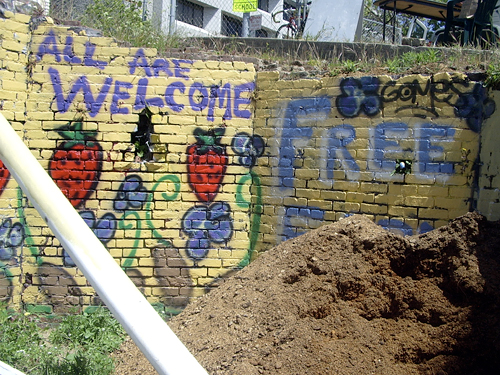When I managed a cafe in the Ferry Building, I knew that all I had to do was box up our extra pastries at the end of every day. The next morning, a cheerful volunteer would show up, pick up the boxes and sign off on my tax-deductible tally sheet. Later that day, those pastries, made with organic ingredients and fruit from a local family farm, might be feeding parents and kids at a drop-in center for homeless families, or adding a little bit of sweetness to a seniors' lunch.
There are other ways to turn waste into resources. The easiest way to start? Drop that banana peel into your green bin. One banana peel multiplied by over 700,000 residents in San Francisco alone means that many tons of food waste (everything from that four-day-old hunk of burrito at the back of the fridge to orange peels and onion skins) are diverted from the waste stream every day via the city's green-waste bins. All that stinky stuff goes to Jepson Prairie Organics, a composting facility near Vacaville. Over the course of about 30 days, it's transformed into high-quality compost that's ready for use by local farms, nurseries, and vineyards.
Or, what about starting from the very beginning, and growing more food from scratch right here in the city? Even in cities as highly populated as San Francisco, Oakland, and Berkeley, a surprisingly amount of arable land is still available. Just look at the Free Farm, which was started on a vacant lot at Gough and Eddy Streets in January of this year.
Pastor Megan Rohrer, a young Lutheran pastor who works with a variety of homeless communities around the city as the executive director of Welcome Ministry, wanted to expand the work she was doing, going from feeding the hungry of San Francisco to growing food for those same communities. The St. Paulus Lutheran church was willing to offer an empty lot it owned to her and a dedicated community of volunteers to make a garden.
Meanwhile Tree, a longtime food-justice activist and community gardener as well as the founder of the Mission's popular Free Farmstand, was looking for a place to grow more local food to supply the farmstand. Once Megan's church connections met Tree's gardening expertise, the Free Farm was born. With grants from the Mesa Foundation along with several local Episcopal and Lutheran churches, plus a whole lot of wheelbarrow-pushing volunteer labor, the weedy lot has undergone an astonishing transformation.
What was once a trash-strewn, needle-littered eyesore that neighbors called "The Pit" is now a welcoming, mural-lined space full of neatly mounded raised beds planted with salad mix, potatoes, beans, broccoli and lettuce. Bricks salvaged from the St. Paulus church (which stood on the space before burning down in 1995) now form strawberry beds on the hillside and a winding spiral bed planted with flowers, herbs, and vegetables. Cold frames and a newly built greenhouse are filled with trays of tiny seedlings, everything from kale to tomatoes to marigolds started from seeds donated by church communities across the country. Bright garden-themed murals by local artist Leanne C. Miller cover the concrete wall on the west side, and there are plans to bring more artists and sculptors into the garden to create site-specific works.
Volunteers get down and dirty every Wednesday and Saturday from 10am to 2pm, building infrastructure, hauling mulch, manure and compost, planting seedlings, waterings, and more. A volunteer-made vegan lunch, often featuring produce harvested from the garden, is shared by all. Volunteers will also share in the harvest, with excess supplying the Free Farmstand (Rohrer hopes to establish another neighborhood Free Farmstand on the site) as well as providing fresh local produce for twice-weekly homeless dinners organized by Welcome. (For more information on Welcome's additional garden projects around the Bay Area, go to Urban Share.)
At the educational Garden for the Environment in the Inner Sunset, weekend workshops teach everything from composting basics to chicken husbandry. Want to spread the word? If you're a San Francisco resident, you can sign up for a three-month gardening and compost educator program that will give you all the necessary tools to teach the basics of urban green gardening and composting. Just want to do a little digging? Volunteer days are Wednesday and Saturdays, 10am to 3pm, with pizza from nearby Arizmendi Bakery to share. The garden's also a great place to get ideas for your own backyard. Organized by concept, there are examples of low-water gardens, native plants, edibles, and more.
In association with the SF Parks Trust, the Garden for the Environment is also offering Garden City, a three-part class on creating an urban farm or community garden, on May 2nd, 9th, and 16th. Topics include locating and identifying available land, working with the city to get the proper permits, building a community of volunteers, and the horticultural nuts and bolts of productive edible gardening and landscaping.
